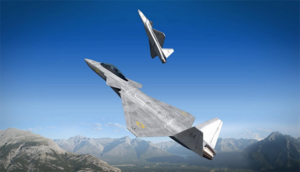ASA VOT 14 Hotvemm (Pacifica)
| ASA VOT 14 Hotvemm | |
|---|---|

| |
| Two Sedunnic Air Force VOT 14 As | |
| Role | Multirole fighter |
| National origin | Sedunn |
| Manufacturer | ASA |
| First flight | 13 September 2006 (VOT 14 A) |
| Introduction |
|
| Status | In service |
| Primary users | Sedunnic Air Force
|
| Produced | 2006–present |
| Number built | 500+ |
The ASA VOT 14 Hotvemm (IPA: [ˈhuːtvemː]; Austral: shadow) is a single-engine, canard delta-wing, stealth multirole fighter aircraft designed and built by ASA by request of the Sedunnic Military Materiel Agency for use in the Sedunnic Air Force and the Sedunnic Navy. The VOT 14 is capable of shifting between air supremacy, interdiction, reconnaissance and attack roles during flight and is thus also labelled a swing-role fighter. The VOT 14 is capable of aerial refuelling and is designed to allow landing on rudimentary runways and public roads as part of the Sedunnic force dispersal doctrine. Variants exist that have two seats (VOT 14 B) or are carrier-based (VOT 14 S). As of 2022, over 500 VOT 14s have been built.
The VOT 14's first flight occurred in in 2006 and the first aircraft entered service with the Sedunnic Air Force in March 2014 and the Sedunnic Navy in November 2016. The aircraft has been exported to Erinor & Sereva and the Frost Empire. The aircraft first saw limited action in the later phase of the Military Intervention Against Soormann in 2015 and full-scale combat in 2018 during the Reizen Civil War (Pacifica).
Development
Design
The VOT 14 is a single-engine, supersonic, stealth multirole fighter. Its design emphasises good short take-off and landing performance, low maintenance requirements, modularity and long range lethality. The aircraft has canard control surfaces that generate positive lift at all speeds, and has a delta wing that compensates for the negative lift produced by the pair of rear stabilisers. The canards and rear stabilisers angle downwards to act as air brakes to decrease the landing distance. The airframe is strengthened to withstand a high sink rate. High manoeuvrability is achieved through intentional instability, enabled by digital fly-by-wire control system.